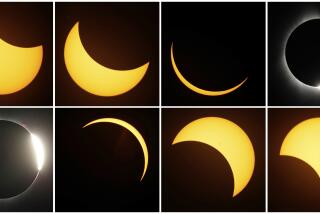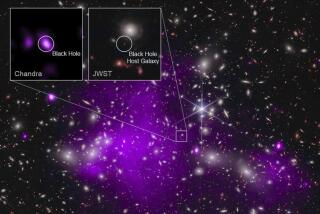‘Cosmos’ recap: Permian period and ‘The Lost Worlds of Planet Earth’
When most of us think about extinction, chances are we recall that infamous asteroid that killed off the dinosaurs 66 million years ago – a.k.a., the K/T extinction event. This week’s episode of “Cosmos”: “The Lost Worlds of Planet Earth,” takes us back 252 million years, to another, far worse mass extinction that wiped out nine out of 10 of all living species at the end of what’s known as the Permian period.
Earth was a very different place back then; as host Neil de Grasse Tyson reminds us repeatedly, “The past is another planet.” The constellations in the night sky were different, the atmosphere was different, and so were the flora and fauna. You could call it the Era of the Giant Insects, an entomophobic’s nightmare – and “Cosmos” drives the horror home with CGI dragonflies the size of eagles and an alligator-sized millipede slithering across the screen. (Seriously, that giant scorpion is straight out of 1950s B movie.)
There was an abundance of oxygen in the atmosphere, which allowed such creatures to thrive – at least for a time. But then Siberian volcanoes started erupting like crazy, spewing carbon dioxide and methane into the atmosphere and molten lava across millions of miles of Earth’s surface. The ocean got hotter, and far more acidic, and global temperatures careened between extremes of hot and cold. Few species were able to evolve rapidly enough to adapt. There’s a reason this period is sometimes called the Great Dying.
Making matters worse, the continents were shifting too, changing the course of ocean currents, with even more drastic climate shifts. Believe it or not, continental drift was once a highly controversial theory. A 16th century Flemish cartographer named Abraham Ortelius mused on the possibility that the continents had once been joined as a single giant land mass. But it wasn’t until 1912 that Alfred Wegener published a full hypothesis – and was roundly ridiculed for it.
His colleagues preferred the notion of sunken land bridges that had once connected the continents, which they felt would account for the fact that the fossils of the same extinct species had been found on at least two separate continents. Wegener disagreed. He became a bit of a pariah in the scientific community; in fact, the American Assn. for Petroleum Geologists hated the idea so much, it once organized an entire symposium just to oppose the continental drift hypothesis. Wegener perished during an expedition to Greenland in 1930, never suspecting that he would be deemed one of the greatest geologists in history for his insight.
The eventual acceptance of continental drift is partly due to the efforts of geologist Marie Tharp. (Hurrah, we have another female scientist!) She held advanced degrees in geology and mathematics – unusual for a woman in the 1940s – and wound up working at Columbia University with a colleague, Bruce Heezen, to map the topology of the ocean floor. He would go on the expeditions (women weren’t allowed on ships), and she would use the data he brought back for her maps.
That’s when she spotted what we now know as the Mid-Atlantic Ridge, a mountain range under the water. Here we get a charming animated sequence where Heezen basically pats her on the head and suggests she might want to keep mum about that, since it was clearly evidence for continental drift – and she wouldn’t want to be associated with that crazy Wegener fellow, would she? Fortunately, Heezen came around in the end; and the evidence for plate tectonics and continental drift piled up rapidly after that.
After a brief foray to marvel at the bioluminescent species found deep in the ocean, in the Mariana Trench, Tyson brings us back to present-day New Jersey, emphasizing that there is a “lost world” buried beneath our feet wherever we walk. The stability of the Earth is an illusion, he tells us; our lives are just too short to notice, since the planet’s geo-dynamics play out over time scales of millions and billions of years. It’s still changing. And that means, “Our future is also another planet.”
Granted, we’re in an unusually stable period, one that should last another 50,000 years – except we’re accelerating matters by dumping huge amounts of carbon dioxide into the atmosphere at a rate not seen since the Permian era. Our reckless disregard for how our actions are affecting the climate won’t matter to the Earth itself, which will endure long after the human race has died out. We’ll just make it uninhabitable for us, thereby joining the dinosaurs, trilobites and countless other species in the Hall of Extinction – unless we have the will to summon all our ingenuity so that our species can endure a bit longer.
More to Read
The complete guide to home viewing
Get Screen Gab for everything about the TV shows and streaming movies everyone’s talking about.
You may occasionally receive promotional content from the Los Angeles Times.






